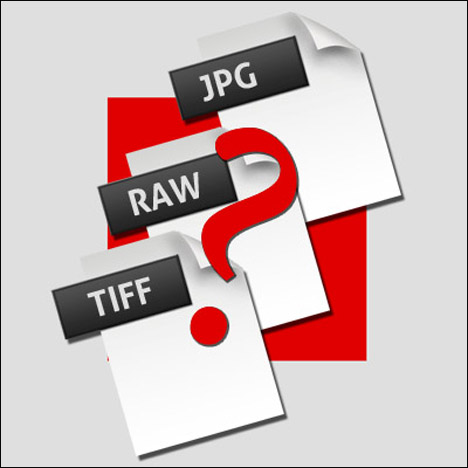RAW, TIFF or JPEG? The difference lies in the accuracy of fine detail, colour encoding and the amount of compression. Let us focus on each of the three formats in turn.

1. JPEG (Joint Photographic Experts Group) format
The most commonly used! Colours obtained by combining the primary colours: red, green, blue. Each primary colour is encoded with 8 bits of precision, giving 256 levels. The number of colours possible is therefore 256 (red) x 256 (green) x 256 (blue) = 16.7 million.
- JPEG has a built-in compression process. The greater the compression, the less fine colour detail is represented in the image pixels. Result: visible loss of image quality with blocking and artefacts.
- Each time you open and re-save a JPEG file, the compression process (even if slight) will lead to further loss of detail. To limit the amount of compression, always save your pictures using the minimum compression setting. N.B.: Different software offers different options:
- if it offers a "Quality" setting, enter the highest value;
- if it offers a "Compression" setting, enter the lowest value. - Advantage: file size is greatly reduced!
Use: sending and receiving images over the Internet, creating images for web sites or sending files to photo laboratories.
2. RAW formats
The RAW format is not defined by any single standard. Each camera manufacturer has its own proprietary format, with a different file extension: .CR2, .NEF, .RAF, .PEF, .X3F, etc. What is the special feature it offers? As the name suggests, it preserves the raw data from the sensor, and therefore contains much finer detail than a JPEG file: a RAW file encodes colour information with 12 or 14 bits of resolution, i.e. 16,384 levels per primary colour!
- They are designed to be converted to one of the standard universal formats (JPEG, TIFF, etc.). Any edits are non-destructive: they are stored in a separate file, ensuring that no data from the original RAW file is lost.
- When using the RAW format, the image can be interpreted in a wide variety of ways without losing any of the original detail.
- It is fairly memory hungry (3-4 times larger than a JPEG)!
Hands on! Saving as RAW+JPEG
Your camera lets you to save a single photo in two different formats at once: JPEG, RAW, RAW + JPEG. Save in both RAW and JPEG format, storing them in two separate files: RAW for image processing, and JPEG for quick viewing.
3. TIFF (Tagged Image File) format
This is a format commonly used in the graphics industry. It is non-destructive, as every single pixel is stored in the file, thus retaining the maximum image quality possible.
- It may include lossless compression techniques, the most common of which is LZW.
- Main disadvantage: the file size! Uncompressed, the file size is 6-7 times larger than that of a JPEG; with LZW compression, this is reduced to 3-4 the size of a JPEG.
Use: keep TIFFs for saving a final version of a file after you have made any required edits in your image processing software. Fine details of the picture will then be retained.
Recommended product:
Discovery packs
